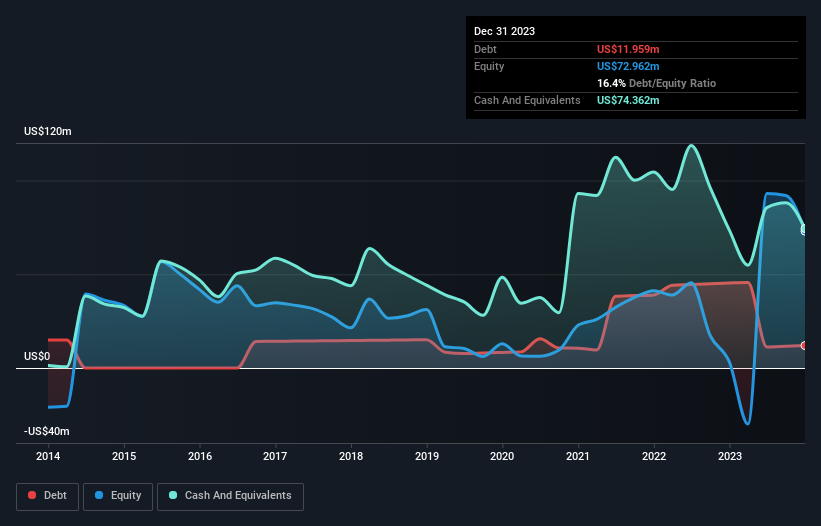David Iben put it well when he said, 'Volatility is not a risk we care about. What we care about is avoiding the permanent loss of capital.' So it seems the smart money knows that debt - which is usually involved in bankruptcies - is a very important factor, when you assess how risky a company is. We can see that SCYNEXIS, Inc. (NASDAQ:SCYX) does use debt in its business. But should shareholders be worried about its use of debt?
Why Does Debt Bring Risk?
Debt and other liabilities become risky for a business when it cannot easily fulfill those obligations, either with free cash flow or by raising capital at an attractive price. In the worst case scenario, a company can go bankrupt if it cannot pay its creditors. However, a more common (but still painful) scenario is that it has to raise new equity capital at a low price, thus permanently diluting shareholders. Having said that, the most common situation is where a company manages its debt reasonably well - and to its own advantage. When we think about a company's use of debt, we first look at cash and debt together.
Check out our latest analysis for SCYNEXIS
How Much Debt Does SCYNEXIS Carry?
As you can see below, SCYNEXIS had US$12.0m of debt at December 2023, down from US$45.4m a year prior. But on the other hand it also has US$74.4m in cash, leading to a US$62.4m net cash position.

How Strong Is SCYNEXIS' Balance Sheet?
According to the last reported balance sheet, SCYNEXIS had liabilities of US$16.3m due within 12 months, and liabilities of US$39.1m due beyond 12 months. On the other hand, it had cash of US$74.4m and US$21.8m worth of receivables due within a year. So it actually has US$40.7m more liquid assets than total liabilities.
This luscious liquidity implies that SCYNEXIS' balance sheet is sturdy like a giant sequoia tree. Having regard to this fact, we think its balance sheet is as strong as an ox. Succinctly put, SCYNEXIS boasts net cash, so it's fair to say it does not have a heavy debt load!
It was also good to see that despite losing money on the EBIT line last year, SCYNEXIS turned things around in the last 12 months, delivering and EBIT of US$73m. When analysing debt levels, the balance sheet is the obvious place to start. But ultimately the future profitability of the business will decide if SCYNEXIS can strengthen its balance sheet over time. So if you want to see what the professionals think, you might find this free report on analyst profit forecasts to be interesting.
Finally, while the tax-man may adore accounting profits, lenders only accept cold hard cash. While SCYNEXIS has net cash on its balance sheet, it's still worth taking a look at its ability to convert earnings before interest and tax (EBIT) to free cash flow, to help us understand how quickly it is building (or eroding) that cash balance. Over the last year, SCYNEXIS recorded free cash flow worth a fulsome 83% of its EBIT, which is stronger than we'd usually expect. That positions it well to pay down debt if desirable to do so.
Summing Up
While we empathize with investors who find debt concerning, you should keep in mind that SCYNEXIS has net cash of US$62.4m, as well as more liquid assets than liabilities. And it impressed us with free cash flow of US$60m, being 83% of its EBIT. So is SCYNEXIS's debt a risk? It doesn't seem so to us. When analysing debt levels, the balance sheet is the obvious place to start. However, not all investment risk resides within the balance sheet - far from it. For instance, we've identified 3 warning signs for SCYNEXIS (1 is significant) you should be aware of.
At the end of the day, it's often better to focus on companies that are free from net debt. You can access our special list of such companies (all with a track record of profit growth). It's free.
New: Manage All Your Stock Portfolios in One Place
We've created the ultimate portfolio companion for stock investors, and it's free.
• Connect an unlimited number of Portfolios and see your total in one currency
• Be alerted to new Warning Signs or Risks via email or mobile
• Track the Fair Value of your stocks
Have feedback on this article? Concerned about the content? Get in touch with us directly. Alternatively, email editorial-team (at) simplywallst.com.
This article by Simply Wall St is general in nature. We provide commentary based on historical data and analyst forecasts only using an unbiased methodology and our articles are not intended to be financial advice. It does not constitute a recommendation to buy or sell any stock, and does not take account of your objectives, or your financial situation. We aim to bring you long-term focused analysis driven by fundamental data. Note that our analysis may not factor in the latest price-sensitive company announcements or qualitative material. Simply Wall St has no position in any stocks mentioned.
About NasdaqGM:SCYX
SCYNEXIS
A biotechnology company, develops medicines to overcome and prevent difficult-to-treat and drug-resistant infections in the United States.
Medium-low risk with excellent balance sheet.
Market Insights
Community Narratives



